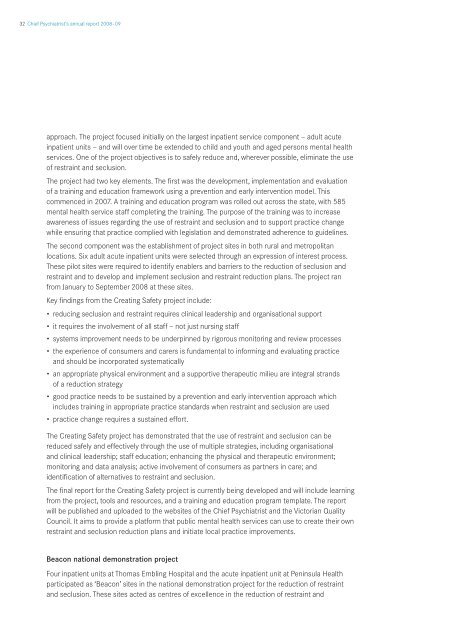Chief Psychiatrist's annual report 2008-09 - Department of Health
Chief Psychiatrist's annual report 2008-09 - Department of Health
Chief Psychiatrist's annual report 2008-09 - Department of Health
Create successful ePaper yourself
Turn your PDF publications into a flip-book with our unique Google optimized e-Paper software.
32 <strong>Chief</strong> Psychiatrist’s <strong>annual</strong> <strong>report</strong> <strong>2008</strong>–<strong>09</strong><br />
approach. The project focused initially on the largest inpatient service component — adult acute<br />
inpatient units — and will over time be extended to child and youth and aged persons mental health<br />
services. One <strong>of</strong> the project objectives is to safely reduce and, wherever possible, eliminate the use<br />
<strong>of</strong> restraint and seclusion.<br />
The project had two key elements. The first was the development, implementation and evaluation<br />
<strong>of</strong> a training and education framework using a prevention and early intervention model. This<br />
commenced in 2007. A training and education program was rolled out across the state, with 585<br />
mental health service staff completing the training. The purpose <strong>of</strong> the training was to increase<br />
awareness <strong>of</strong> issues regarding the use <strong>of</strong> restraint and seclusion and to support practice change<br />
while ensuring that practice complied with legislation and demonstrated adherence to guidelines.<br />
The second component was the establishment <strong>of</strong> project sites in both rural and metropolitan<br />
locations. Six adult acute inpatient units were selected through an expression <strong>of</strong> interest process.<br />
These pilot sites were required to identify enablers and barriers to the reduction <strong>of</strong> seclusion and<br />
restraint and to develop and implement seclusion and restraint reduction plans. The project ran<br />
from January to September <strong>2008</strong> at these sites.<br />
Key findings from the Creating Safety project include:<br />
• reducing seclusion and restraint requires clinical leadership and organisational support<br />
• it requires the involvement <strong>of</strong> all staff — not just nursing staff<br />
• systems improvement needs to be underpinned by rigorous monitoring and review processes<br />
• the experience <strong>of</strong> consumers and carers is fundamental to informing and evaluating practice<br />
and should be incorporated systematically<br />
• an appropriate physical environment and a supportive therapeutic milieu are integral strands<br />
<strong>of</strong> a reduction strategy<br />
• good practice needs to be sustained by a prevention and early intervention approach which<br />
includes training in appropriate practice standards when restraint and seclusion are used<br />
• practice change requires a sustained effort.<br />
The Creating Safety project has demonstrated that the use <strong>of</strong> restraint and seclusion can be<br />
reduced safely and effectively through the use <strong>of</strong> multiple strategies, including organisational<br />
and clinical leadership; staff education; enhancing the physical and therapeutic environment;<br />
monitoring and data analysis; active involvement <strong>of</strong> consumers as partners in care; and<br />
identification <strong>of</strong> alternatives to restraint and seclusion.<br />
The final <strong>report</strong> for the Creating Safety project is currently being developed and will include learning<br />
from the project, tools and resources, and a training and education program template. The <strong>report</strong><br />
will be published and uploaded to the websites <strong>of</strong> the <strong>Chief</strong> Psychiatrist and the Victorian Quality<br />
Council. It aims to provide a platform that public mental health services can use to create their own<br />
restraint and seclusion reduction plans and initiate local practice improvements.<br />
Beacon national demonstration project<br />
Four inpatient units at Thomas Embling Hospital and the acute inpatient unit at Peninsula <strong>Health</strong><br />
participated as ‘Beacon’ sites in the national demonstration project for the reduction <strong>of</strong> restraint<br />
and seclusion. These sites acted as centres <strong>of</strong> excellence in the reduction <strong>of</strong> restraint and

















